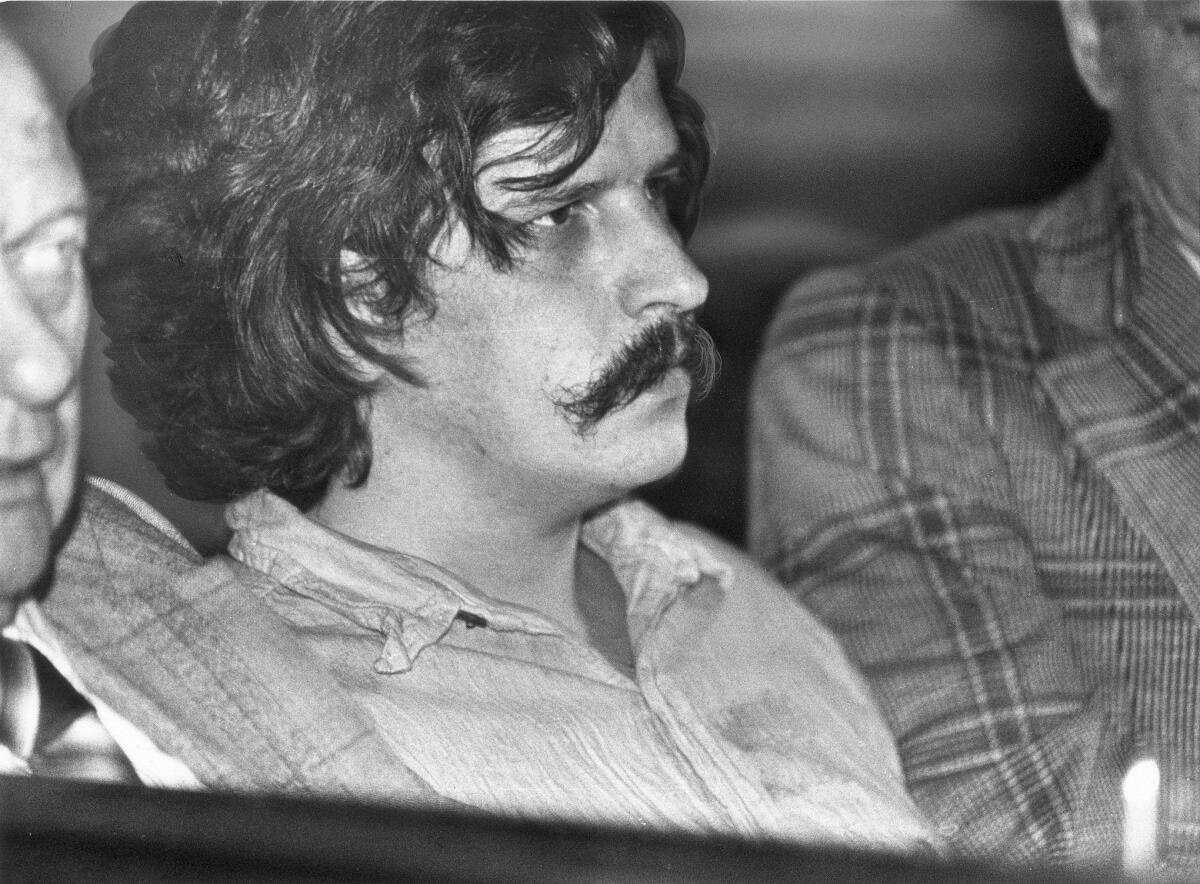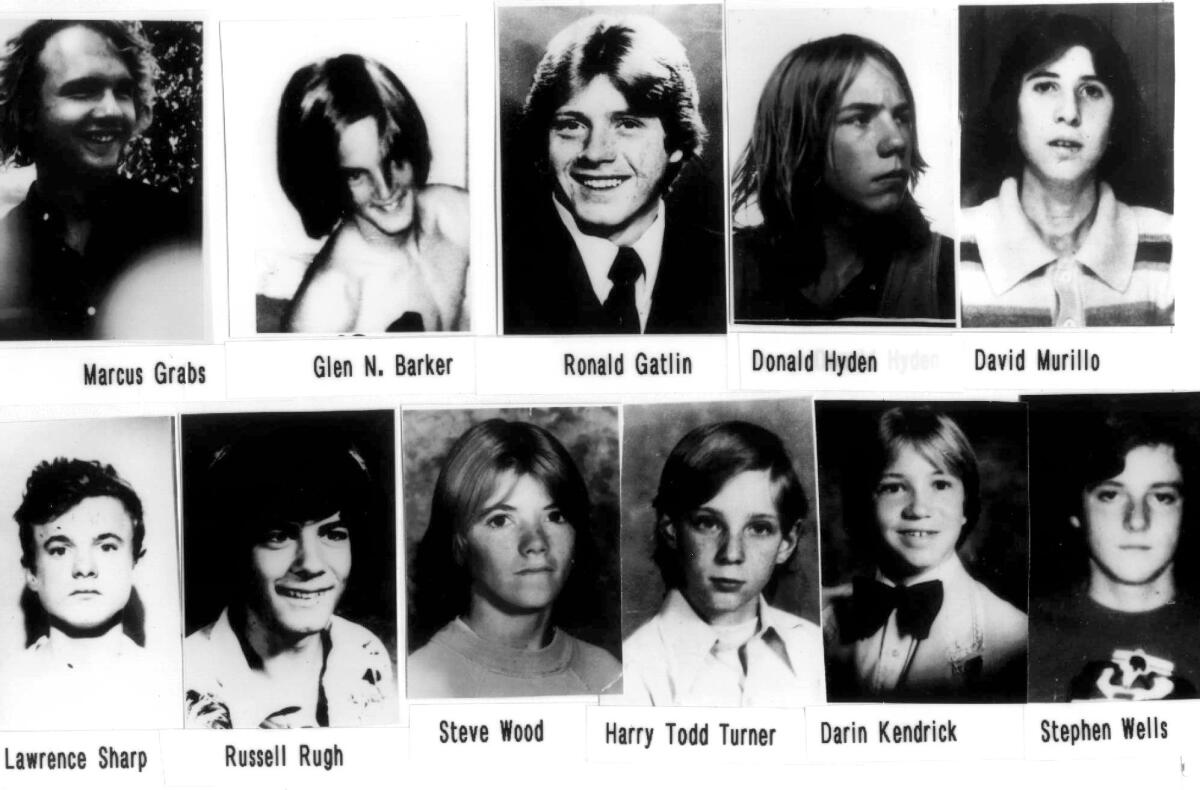From the Archives: ‘Freeway Killer’ William Bonin is executed: Sadistic slayer confessed to 21 murders

- Share via
An accomplice of serial killer William G. Bonin was beaten to death this week by another inmate at Mule Creek State Prison, according to authorities. Gregory M. Miley was serving a life sentence for his role, with Bonin, in the murder of two teenage boys. Here's a look back at Bonin's execution and crimes.
William G. Bonin, the notorious "Freeway Killer" who seared his way into the nation's consciousness with a string of sadistic murders 16 years ago, was executed at San Quentin Prison early today, becoming the first person in California to die by lethal injection.
Bonin, a former Downey truck driver who confessed to raping, torturing and killing 21 boys and young men, was put to death in the prison's converted gas chamber. Bonin was declared dead at 12:13 a.m.
At 10:47 p.m., the U.S. Supreme Court rejected a desperate, last-minute appeal by Bonin's attorneys to spare his life. Earlier Thursday, a three-judge panel of the 9th U.S. Circuit Court of Appeals in San Francisco, then a larger panel from the same court, refused to block the execution.
They feel that my death will bring closure. But that's not the case. They're going to find out.
— William G. Bonin
Outside the prison gates, hundreds of death penalty opponents and supporters engaged in raucous, often angry demonstrations, becoming increasingly confrontational as the night wore on.
Bonin, 49, was the third prisoner in California to be executed since the death penalty was reinstated in 1976.
One of the most prolific killers in U.S. history, Bonin spent Thursday peacefully, prison officials said, reading his mail and chatting with relatives, friends and attorneys.
Moved at 6 p.m. to a special "death watch" cell beside the execution chamber, Bonin ate a final meal of coffee ice cream and pepperoni and sausage pizza, and watched the television game show "Jeopardy."
Bonin appeared resigned and met with a Catholic chaplain. "He's communicating well and seems relaxed," said San Quentin spokeswoman Joy Macfarlane.
Earlier, he also found time to speak to a San Francisco radio station. In an interview with KQED-FM, Bonin said he had "made peace with it" and has even managed to joke with the prison warden about his impending death.
But the mass murderer had chilling words for the family members of his victims, some of whom planned to attend his execution in an effort to find a measure of peace themselves.
"They feel that my death will bring closure," Bonin said. "But that's not the case. They're going to find out."
As the light faded, relatives of several of Bonin's victims arrived at the prison to witness the execution. Some had to elbow their way in through a crowd of photographers.
Authorities tightened security at the prison and throughout the area. Prisoners were locked in their cells, their recreation times canceled. Freeway offramps into San Quentin were closed. Roads into San Quentin Village, a bay-side hamlet beside the prison, were blocked.
Sheriff's deputies and correctional officers swarmed in and around prison grounds, apparently to ward off any trouble from death penalty opponents and supporters who held raucous demonstrations just outside. The crowd swelled, with people streaming into the area as midnight approached.
"I wish I could be in there watching," said Erwin Baumgartner, a glazier and adamant supporter of capital punishment. "I think the man should die. . . . I don't think it's cruel and I don't think it's unusual. It happens all over the world."

Michael Levine, a San Francisco middle school teacher, was videotaping the demonstrations to show to his class, which he said included several children of San Quentin inmates and the son of the prison chaplain.
Levine said he understood the views of death penalty advocates, especially after talking to relatives of several victims. "But morally, I don't think the state should model killing," he said.
Many in the crowd--which included actor Mike Farrell--were death penalty opponents. Some carried candles. Others chanted, strummed guitars and sang. Shouting matches broke out, as demonstrators hurled insults back and forth.
Berkeley resident Eve Sweetser said the tone was much angrier than the previous demonstrations she attended before other executions.
Earlier, several of Bonin's victims and relatives of several others gathered near the prison for an unusual news conference in the hours before his scheduled death.
"I just can't wait to see [Bonin] take his last breath," said Sandra Miller, the mother of Russell Duane Rugh, 15, of Garden Grove, who was last seen near his home waiting for a bus to work at a fast-food restaurant. His body was found March 22, 1980, beside Ortega Highway, alongside the body of 14-year-old Glen Barker of Huntington Beach, another of Bonin's victims.
Miller said she regrets Bonin's death was to be relatively painless. As she spoke, Miller hugged David McVicker, a Santa Ana disc jockey whom Bonin raped at gunpoint in 1975. McVicker was 14.
"I think they ought to give him over to the [victims'] parents and David," Miller said. "We'd fix him."
See the most-read stories this hour >>
The execution prompted small protests in Southern California on Thursday night.
"What he did to those children is wrong. Those children were our future. . . . He's taken that away from us," said Sister Catherine Vallejo, a Catholic nun who joined 22 other death penalty opponents for a rush-hour demonstration in Orange. "But to take Bonin's life is not going to make anything right or teach us to be better human beings."
About three dozen death penalty opponents held a candlelight vigil at Civic Center Plaza in Santa Ana, singing and praying in the chill air.
Bonin's lawyers sought to block the execution by arguing their client did not receive a fair trial and was denied a choice of the method of his execution.
Gov. Pete Wilson this week denied a separate plea that sought clemency on grounds Bonin received inadequate legal representation during a pair of trials in Los Angeles and Orange counties. Wilson, who could have reduced the sentence to life in prison without possibility of parole, said Bonin's guilt was "beyond dispute."
On Thursday, Wilson said there was no reason to halt the execution, and described the "Freeway Killer" as a "poster child for capital punishment."
Bonin was convicted of raping and killing 14 boys and young men, some of them hitchhikers, during a yearlong spree that spread fear across Southern California and all but ended hitchhiking among California teens.
Bonin's rampage coincided with a similar series of murders later linked to serial killer Randy Kraft. Kraft was convicted in 1989 of 16 murders and awaits execution.
Bonin was arrested in Hollywood on June 11, 1980, while sodomizing a 17-year-old runaway from Orange County. In Bonin's van, police found gear that Bonin had used to rape and strangle his young victims: wire, rope and a tire iron with which he twisted victims' T-shirts around their necks.
Friends who helped Bonin carry out some of the murders implicated him as the mastermind and, in court testimony, portrayed a killer with an insatiable lust for young men.
In separate trials, Bonin was found guilty of 10 murders in Los Angeles County in 1982 and four more in Orange County in 1983.
The performance of Bonin's lead trial attorney, William Charvet, became a focus of Bonin's appeals. His legal team in the state public defender's office sought a new trial, contending Charvet made an inappropriate book deal with Bonin and failed to raise Bonin's abuse-ridden childhood during the trials.
Born Jan. 8, 1947, Bonin grew up in a home run by a violent father who drank and gambled to excess, once losing the family home, according to a psychiatrist report submitted for Bonin's appeal. His parents often left Bonin and his two brothers alone, according to defense statements and doctors' reports. His parents later sent him to an orphanage.
At age 8, Bonin was sexually assaulted while living in a Connecticut detention center and later fondled a brother and neighborhood boys, Bonin told doctors. His mother, Alice Benton, told a psychiatrist she suspected her father molested William as he had abused her, according to a court declaration by a New York psychiatrist who interviewed Benton.
The Homicide Report: A story for every victim >>
Bonin served as a helicopter gunner in Vietnam, where, it was learned later, he assaulted two soldiers under his command. Later, Bonin was convicted in 1969 of sexually assaulting five boys in South Bay communities.
In 1975, he was convicted of raping McVicker, whom he picked up hitchhiking in Garden Grove. Bonin told a police officer that he would not leave a living witness next time.
The murders began in 1979--a year after Bonin's release from state prison--when the bodies of victims began turning up next to roadways and behind buildings across several counties. Most of the young victims, ages 12 to 19, were dumped nude, some bearing cigarette burns or welts and showing evidence of sexual assault.
Bonin has been on California's death row for nearly 13 years.
The last California inmate put to death was David Edwin Mason, a convicted killer of five who was executed in 1993. Robert Alton Harris, executed in 1992 for killing two teenagers, was the only other California prisoner put to death since the U.S. Supreme Court reinstated the death penalty. Both died in the gas chamber.
Ellingwood and Moehringer reported from San Quentin and Trounson from Costa Mesa. Also contributing to this report were Times staff writers Dexter Filkins in San Quentin and Deborah Schoch in Orange County.
Next to Die?
In addition to William Bonin, California's Death Row has 435 inmates--427 men and eight women. There's no sure way to predict who will be executed next, but state officials say these three men are the most likely candidates to follow for lethal injections:
Keith Daniel Williams

Sentenced April 13, 1979, for the kidnap, robbery and murder of three farm workers in Merced County. Each victim had been shot at least twice with a .22 caliber pistol. After the murders, Williams was quoted as saying: "I love to kill."
The U.S. Supreme Court on Tuesday cleared the way for Williams' execution, denying to hear his case. The attorney general's office says he is likely the next prisoner to be executed and that the office will schedule his execution for the next 30-60 days.
Update: Williams was executed on May 3, 1996.
Alfred Dyer
Sentenced for Nov. 9, 1980, murders of two Alameda County residents. Angry about some lost jewelry, Dyer took four people into the hills outside Oakland, forced them to lie down and shot them all. Two survived.
Dyer's execution has been scheduled and canceled three times. A host of state and federal judges have upheld his sentence; the case is currently before the 9th U.S. Circuit Court of Appeal.
Update: Dyer, now 63, remains incarcerated in California State Prison Solano as of May 2016.
William Kirkpatrick Jr.
Sentenced for the Sept. 17, 1983, murder of two clerks during a robbery at a Burbank Taco Bell. The employees were found in a closet, shot in the backs of their heads. Kirkpatrick made off with $625.
In 1990, Kirkpatrick stabbed his defense attorney, who had come to visit him on Death Row. Last year, he wrote the U.S. Supreme Court, saying: "I feel no remorse! Give me my execution date and kill me!!!" Apparently, he changed his mind. An execution date was scheduled for Jan. 26, but postponed pending his appeal. Among other things, Kirkpatrick is asking for a new lawyer.
Update: Kirkpatrick remains incarcerated at San Quentin as of May 2016.
Source: State attorney general's office; California Department of Corrections
Sign up for Essential California
The most important California stories and recommendations in your inbox every morning.
You may occasionally receive promotional content from the Los Angeles Times.







